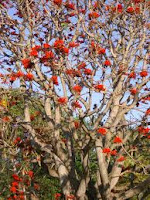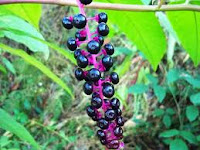The adder’s tongue fern resembles the cuckoo-pint and the Arum or Calla lily, but you can see it in the months of June to August only (at least in Britain
 It is native to
It is native to Because the ancient herbalists believed that like cured like, and thought that the spike looked like a snake’s tongue, this fern was used as an antidote to snake bites. (They believed that red herbs and flowers were good for the blood and so on.)
 The leaves of this fern are reportedly edible when cooked and can be used as a green vegetable. The distilled water of the plant was used for eye problems, and the ointment Culpepper describes was know as Green Oil of Charity, made from two pounds (one kilo approximately) of leaves, ½ pint of oil and 1½ pounds of suet all melted together, and boiled until the leaves were crispy, then strained and used for ointment for wounds.
The leaves of this fern are reportedly edible when cooked and can be used as a green vegetable. The distilled water of the plant was used for eye problems, and the ointment Culpepper describes was know as Green Oil of Charity, made from two pounds (one kilo approximately) of leaves, ½ pint of oil and 1½ pounds of suet all melted together, and boiled until the leaves were crispy, then strained and used for ointment for wounds. In Britain England
The English herbalist, Nicholas Culpeper, writing his Complete Herball in the 17th century has this to say of Adder’s tongue: -
 “It is temperate in respect of heat, but dry in the second degree. The juice of the leaves, drank with the distilled water of horse-tail, is a singular remedy for all manner of wounds in the breasts, bowels, or other parts of the body, and is given with good success to those that are troubled with casting, vomiting, or bleeding at the mouth or nose, or otherwise downwards. The said juice given in the distilled water of oaken buds, is very good for women who have their usual courses, or the whites flowing down too abundantly. It helps sore eyes. Of the leaves infused or boiled in oil, omphacine or unripe olives, set in the sun for certain days, or the green leaves sufficiently boiled in the said oil, is made an excellent green balsam, not only for green and fresh wounds, but also for old and inveterate ulcers, especially if a little fine clear turpentine be dissolved therein. It also stayeth and refresheth all inflammations that arise upon pains by hurts and wounds.”
“It is temperate in respect of heat, but dry in the second degree. The juice of the leaves, drank with the distilled water of horse-tail, is a singular remedy for all manner of wounds in the breasts, bowels, or other parts of the body, and is given with good success to those that are troubled with casting, vomiting, or bleeding at the mouth or nose, or otherwise downwards. The said juice given in the distilled water of oaken buds, is very good for women who have their usual courses, or the whites flowing down too abundantly. It helps sore eyes. Of the leaves infused or boiled in oil, omphacine or unripe olives, set in the sun for certain days, or the green leaves sufficiently boiled in the said oil, is made an excellent green balsam, not only for green and fresh wounds, but also for old and inveterate ulcers, especially if a little fine clear turpentine be dissolved therein. It also stayeth and refresheth all inflammations that arise upon pains by hurts and wounds.”




































